How Not to Work with Historic Recipes… Buckwheat Pancakes
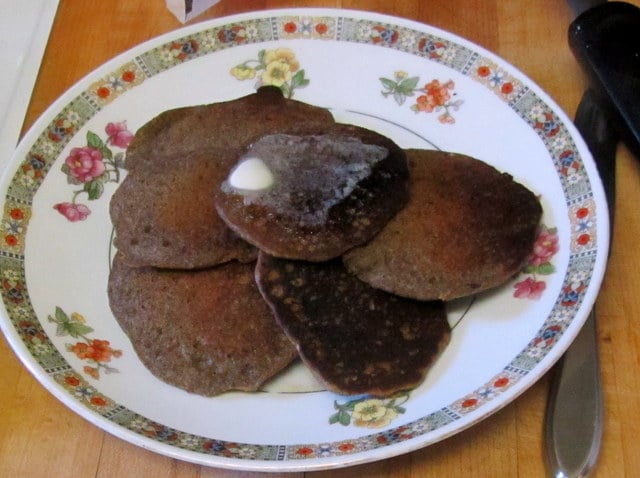 The pancakes are really good… so if I were just doing this for myself, I’d be happy. But to share with you people? Um…
The pancakes are really good… so if I were just doing this for myself, I’d be happy. But to share with you people? Um…
OK, let’s start here. I have quite a few vintage-to-antique cookbooks dating as far back as the late 19th Century. I have cooked from them for years, so I’m used to the sometimes more casual approach to measurements that some of them have. (I also, for fun, work with recipes dating back to the 13th century, which have even more casual measurements – if any – and everything in between. And some of my friends, who have done that with me, are laughing as they read this…) When I was writing about buckwheat, I went back to the old books, and found a really interesting recipe for buckwheat pancakes.
I have The Winston Cookbook: Planned for a Family of Four by Helen Cramp. (Published by The John C. Winston Company, copyright 1913.) This was a discard from the local Public Library (where my great aunt worked.) My grandmother clearly cooked from it a lot – the book is pretty worn, some of which probably happened before she ever got it and was the reason it was discarded (there is a note that pages had been torn out) but there are also notes in her handwriting all over it. Recipes written in margins and on the backs of the color plates, a comment in the canning section that “one peck of green beans (is) enough to handle at one time,” X marked next to recipe titles. (Did she like them? Dislike them? I have no idea. She lost her sight – and stopped cooking – before I was five.)
In the chapter Bread, Hot-cakes, Etc. I found
Buckwheat Cakes No. 2.
1 pint buttermilk
Buckwheat flour
¼ cake yeast
Pinch of salt
1 tablespoon molasses
¼ teaspoon baking soda
Into the buttermilk stir enough flour to make a soft batter;add the yeast cake dissolved in a little warm water and the salt and beat thoroughly. Let rise over night and in the morning stir in the molasses and baking soda. Save a cup of the batter to be used instead of yeast for the next baking.
Well. It was the last line that got me, really… keeping a starter, like a sourdough. So, I want to play with it – make the first batch, but then also see how it develops. (And buttermilk is cultured from a starter, too – can I make later batches with regular milk, assuming the culture is present and will inoculate it? Should I use buttermilk every, oh, third or fourth batch to be sure? Or will I really need to keep using it?)
So, I decided to make it. But I didn’t want to tell you to just add “enough flour to make a soft batter.” I mean, most of you can do this, but, especially with something like buckwheat that you may not always have on hand, you need a clue… So I decided to get all sciency. But… I kind of blew it, and forgot a few factors, and wasn’t really very scientific…
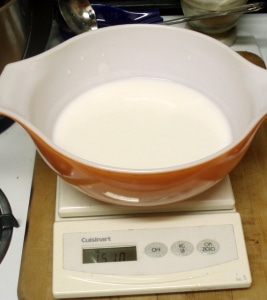 I often work on historic recipes with a friend who actually is a scientist (and is the one laughing at me here… or possibly just being horrified.) At this point, she always says “How much do you think you will need?” because she is looking for precision and reproducible results. So I looked at pancake recipes… and some had a cup of flour to a cup of milk, and some had the same amounts by weight… and I sort of started thinking about that – I’d weigh the buttermilk, then start adding flour, until I had the right texture, and then weigh it to see how much I’d actually added. And I’d measure it by grams, because that is more precise. (Or, actually, because the arithmetic is much easier…) And the pint of buttermilk they called for weighed 505 grams (call it 500…) And so I started…
I often work on historic recipes with a friend who actually is a scientist (and is the one laughing at me here… or possibly just being horrified.) At this point, she always says “How much do you think you will need?” because she is looking for precision and reproducible results. So I looked at pancake recipes… and some had a cup of flour to a cup of milk, and some had the same amounts by weight… and I sort of started thinking about that – I’d weigh the buttermilk, then start adding flour, until I had the right texture, and then weigh it to see how much I’d actually added. And I’d measure it by grams, because that is more precise. (Or, actually, because the arithmetic is much easier…) And the pint of buttermilk they called for weighed 505 grams (call it 500…) And so I started…
Note – Buttermilk is thicker and less… liquidy… than the milk my other recipes called for.
Note – All the other recipes, unlike this one, also had eggs and either oil or melted butter… and I totally disregarded that working out liquid/solid proportions… (No, I do not know where my brain was…)
Note – Buckwheat flour weighs 4½ oz per cup (according to King Arthur Flour, who should know.) So, while I did see one source calling for equal weights, the fact that most called for equal numbers of measuring cups should have had me aiming at 250 grams or so to begin.
Note – My scale may be wonky… Well, unlike the others, that doesn’t count as something I should have known, I didn’t realize it until a day later, when it wouldn’t hold a tare weight. So I don’t know if that factored into this at all. Probably not, but… as I worked it did keep shutting down.
Do you see where I’m going here?
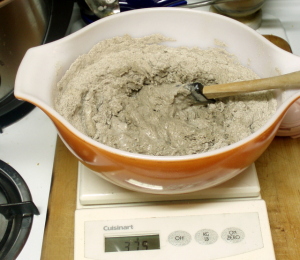 So. I made a note of the net weight. Then I made a note of the gross weight, so I could start from scratch if the scale shut down. (1505. That bowl is 1 kilo! That’s going to be useful in future… ) Then I hit tare and started adding flour, and trying to mix it in before the scale shut down (not a problem I’d really expected… yes, I now also have a new battery in it.)
So. I made a note of the net weight. Then I made a note of the gross weight, so I could start from scratch if the scale shut down. (1505. That bowl is 1 kilo! That’s going to be useful in future… ) Then I hit tare and started adding flour, and trying to mix it in before the scale shut down (not a problem I’d really expected… yes, I now also have a new battery in it.)
So… I dumped in some flour, stirred a little, added some, stirred a little, added more…. oops… 325 g was suddenly much too much. This was no soft batter – it had the texture of clay.
OK, so now I tossed out the inept non-scientific sciency stuff, and worked on rescuing the batter. First, I poured in, a little at a time, all the rest of the buttermilk I had… which was probably about a cup. (I bought a quart, I’d used a glass in something else.) Then I added a little more plain milk… not at all sure, now, how much.
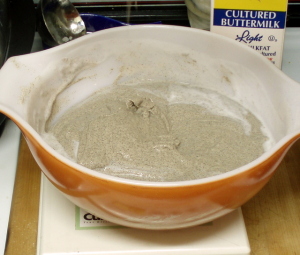 OK, so now I had a consistency like a batter. It’s a bit different than I’m used to with wheat flour – a bit more viscous, interestingly. So, at this point, I went ahead with pancakes – with no idea how much of anything was in it…
OK, so now I had a consistency like a batter. It’s a bit different than I’m used to with wheat flour – a bit more viscous, interestingly. So, at this point, I went ahead with pancakes – with no idea how much of anything was in it…
I decided that, well, yeast grows anyhow… and I was making this in the afternoon, not evening, so it would be sitting about 16 hours, rather than the 10 or so I think of for “Mix this after dinner, use it at breakfast.” So – a cake of moist yeast is the equivalent of a packet of dried yeast, which in turn is 2½ teaspoons. So I softened a rounded half teaspoon (I was past worrying about precise measurements…) in a spoonful of water, and stirred it in, with the salt. Then I set it aside to work overnight.
Note – The original recipe has you add the molasses later – it is flavoring, not something added to feed the yeast. Yeast does perfectly well with just the flour. I make yeast bread without added sugar all the time.
Note – My kitchen is normally quite warm. I had the window open, because it had been hot the day before. A cool front came through that night… So the yeast grew much less than it usually would in my kitchen, but probably about the way it would in a normally cool kitchen. (We tend to ignore ambient temperature as a factor, when it can be a major one.)
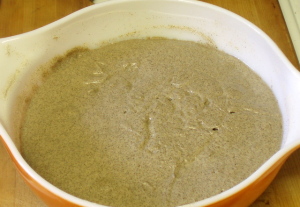 Anyhow – in the morning I found this. I stirred it down, added the baking soda, skipped the molasses because I don’t use added sugar and it is just flavoring and sweetening here (and that tiny amount won’t alter things drastically) and proceeded with pancakes.
Anyhow – in the morning I found this. I stirred it down, added the baking soda, skipped the molasses because I don’t use added sugar and it is just flavoring and sweetening here (and that tiny amount won’t alter things drastically) and proceeded with pancakes.
Well, first I did, in fact, put aside a cup of batter, to play with later. Because I’m crazy that way.
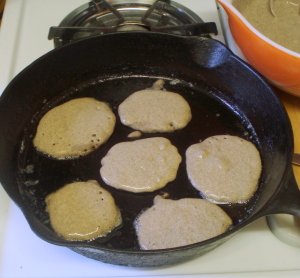 For this, I pulled out the cast iron pan that belonged to the same grandmother who owned the book, heated it and buttered it lightly. I tend to make smaller pancakes, traditionally called Silver Dollar Pancakes, because I can fit several in a pan, they cook more quickly than larger ones, and they’re easier to turn over. So I poured in my dollops of batter, and waited for the bubbles all over the surface that tell me a pancake is cooked enough to turn.
For this, I pulled out the cast iron pan that belonged to the same grandmother who owned the book, heated it and buttered it lightly. I tend to make smaller pancakes, traditionally called Silver Dollar Pancakes, because I can fit several in a pan, they cook more quickly than larger ones, and they’re easier to turn over. So I poured in my dollops of batter, and waited for the bubbles all over the surface that tell me a pancake is cooked enough to turn.
And waited…
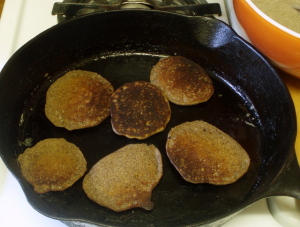 OK, so…. I don’t know if this has something to do with this being, in fact, a gluten free pancake so it behaves differently, or if it is a sign that the yeast wasn’t working, or that I should have increased the baking soda more (though honestly I have no idea why it even calls for baking soda, when it’s really not enough to do much in that much batter, and the yeast should provide enough leavening) but anyhow – no bubbles. But the top was getting the dry look I recognize in other bready foods, so I turned the cakes, and they certainly were cooked enough. Then I just browned the other side, gave them to Rich, made a second batch for myself, and ate them with a little butter.
OK, so…. I don’t know if this has something to do with this being, in fact, a gluten free pancake so it behaves differently, or if it is a sign that the yeast wasn’t working, or that I should have increased the baking soda more (though honestly I have no idea why it even calls for baking soda, when it’s really not enough to do much in that much batter, and the yeast should provide enough leavening) but anyhow – no bubbles. But the top was getting the dry look I recognize in other bready foods, so I turned the cakes, and they certainly were cooked enough. Then I just browned the other side, gave them to Rich, made a second batch for myself, and ate them with a little butter.
And they were good…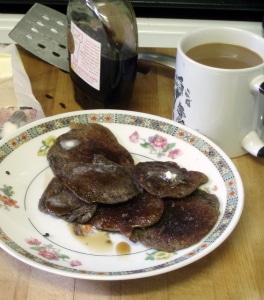
I don’t think they need syrup, but if you do (Rich did) please do use real maple syrup – the flavor of these deserves the flavor of the real stuff, not just sweetness. Or some of that molasses. Or… I’ll be making applesauce and apple butter, soon – these will be wonderful with apple butter. Really, though, that’s gilding the lily – the butter was enough. After breakfast, I went ahead and made up the rest of the batch, so I can now also tell you they microwave nicely, so you can make a batch and use them for several meals. I’ve been eating them with eggs on the side. I did try them once with the beans I eat, but, while that was OK, the beans masked the taste of the pancakes – no point in that. These deserve to stand on their own – with sausage and eggs, the next day.
And now I’m going to go play with the reserved batter. I’m thinking this is something I can just keep in a covered bowl, and mix up the batter at night, and use half in the morning, and… keep going…. I’ll let you know.
I’ll also do this properly, one of these days, and give you a real recipe with real measurements and all, and when I do that I’ll add a note here, so you know it. But I thought I’d give you a glance behind the scenes, as it were – sometimes it doesn’t all go the way you expected (which is sometimes your own silly fault – it mostly was, here.)
But sometimes – you can still have good pancakes.
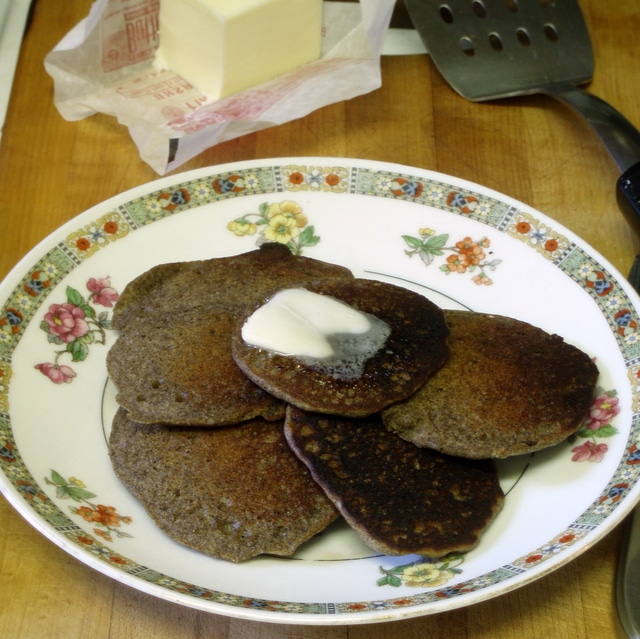
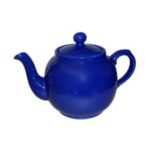
These look interesting, things never work for me without precise measurements. I’ll keep an eye out for when you have the measurements! #recipeoftheweek
Thanks! Right now, I’m playing with keeping starter overnight – sourdough buckwheat pancakes, oh, my! I’ll be writing up both the original and that option – the first batch was milder than the one made from starter, and I can see people liking both options.
And I will give real measurements!
We used to have these quite often, when I was a child. They were always served with Butter and Molasses. It seemed like an old family thing. My Family is Northern European. I know they’re not English. But, I am curious, could the recipe with Molasses be Swedish, which I think it is, or Lithuanian or even Russian. I’m just curious where it comes from.
Oh, wonderful!
And thanks for reminding me of this – I really need to write up this recipe properly…
I have no idea where it came from, originally. I’ve only seen it in this form in vintage American cookbooks – buckwheat was much more common here a century and more ago than it is now. (Somewhat more common than now into the fifties/sixties…)
Russians use buckwheat for blini, which are little pancakes but without the molasses. In fact, I don’t really remember seeing molasses in traditional Northern European cooking at all – though I’m no expert. (Of the cultures you mention, I know nothing about Lithuanian cooking – a little more about Russian, and a fair bit about Scandinavian in general.) Molasses is much more commonly used in America, where it is a byproduct of the sugar industry.
Many cultures in the US adapted old country recipes to more readily available ingredients – could that have happened?
Anne, my boyfriend is thrilled I was able to find this recipe for him – fond childhood memories of his grandparents serving these frequently, without the sweetener. Question please: after you hold aside one cup for the future, do you repeat the recipe above – add buttermilk, buckwheat flour, salt, and yeast or just buttermilk and flour? Thank you!
I’m so delighted! I love moments like this…
Mix in flour, buttermilk and salt. The yeast is still in the reserved batter, and will grow more when you let the next batch rise… It’s essentially like a sourdough starter, if you’ve ever used that. And of course, you can just start fresh each time, if you want – I found it got more tangy over time, so you can see if you like that or not.
And thank you for reminding me of this recipe! I really do need to come back to it… And I hope he enjoys it!